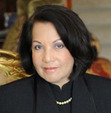Dhows
I was charmed the first time I saw the cluster of ships moored on the harbor of Doha along the Corniche. They were swaying languorously under the midday sun, evoking romance and mystery. Made of wood and burnished in red mahogany stain, they were glossy and lustrous as scimitars. "They are called dhows", my husband had informed me.
A dhow is an Arab sailing vessel with a triangular sail called lateen. In the old days they were also used for pearling and the big ones used to sail to India and Africa for trade, using sails as their only means of propulsion. Their cargo was mostly dates and fish to East Africa and mangrove timber to the lands in the Arabian Gulf. They sailed to foreign ports in the winter, returning home in the summer.
The word dhow is not Arabic; it comes from an African word, daw, Swahili, which refers to the language of East Africa. The dhow used to be manufactured in India but nowadays, the Arabian Gulf produces these boats for recreation and leisure. Many Gulf citizens buy dhows as fishing boats. In Doha, there is a workshop that still builds and repairs traditional dhows. Dhow building is an ancient trade, with major centres in the UAE, Bahrain, Kuwait, and Oman in the Arabian Gulf and Kenya, Tanzania, and Zanzibar. The Dhow Yard in Ajman is said to be the world's largest boat-building yard and dhow-building centre.
Teakwood is used for building and each vessel takes one month to a year to create, depending on the size and shape. The Arabs never used metal ships; all their ships were made of wood. The Gulf Arabs mastered the art of ship building and sailing over many centuries. Ahmed Ibn Majid, a famous Gulf sea pilot showed the Portuguese Vasco de Gama the route from Africa to India. Vasco de Gama is credited in the West for discovering the Cape of Good Hope. Ahmad Ibn Majid was born in Ras Al-Khaima, a small emirate in the UAE.
Dhows are a common sight in Qatar and the rest of the Arabian Gulf. They are still used as fishing boats. Nowadays, dhows are also used for cruising/dining and racing. Dhow-racing season in the UAE starts in September, with 12-man teams of UAE nationals competing in a tournament spread over nine months for the opportunity of winning very lucrative prizes and, equally importantly, the huge honour of upholding an ancient tradition. The final and most prestigious race of the season is from Sir Bu Na'air Island to Dubai, a distance of 54 nautical miles, over a route taken by the early pearling dhows. It seems an exciting sport and more young people are showing interest in dhow-racing as a sport.
In our highly technical world where many ancient traditions are dying, dhow-cruising and dhow-racing are excellent ways to revitalize the ancient art of dhow building. Remnants of Qatar's – and the Arabian Gulf's – seafaring and pearling past are embodied in the dhow.
The sight of a dhow sailing at sunset is lovely, dreamy, and romantic . . . stirring yearnings for exotic places.
[image error]
Painting of a dhow



